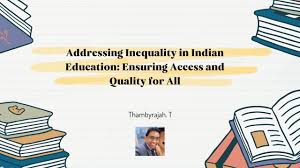Addressing Educational Inequality: The E.W.S and D.G Quota in India
Current Affairs NationalPosted by newadmin on 2025-03-12 12:55:00 |
Share: Facebook | Twitter | Whatsapp | Linkedin Visits: 82

India’s education system has long faced disparities, particularly among underprivileged children. The introduction of the Economically Weaker Section (E.W.S) and Disadvantaged Group (D.G) quota aims to bridge this gap. Under the Right to Education (RTE) Act of 2009, private schools are required to reserve 25% of their seats for children from these backgrounds, which include Scheduled Castes, Scheduled Tribes, orphans, and children with disabilities. The initiative provides a chance for children from economically disadvantaged families to access quality education in private schools, improving their future prospects.
The eligibility for this quota is based on family income, often capped at ₹1 lakh to ₹5 lakh annually. Applicants must submit relevant documents such as income and residence proof. The admission process involves an online application and a lottery system, ensuring fairness in selection.
However, the initiative faces several challenges. The reimbursement process for private schools often encounters delays, and the quota only covers tuition fees, leaving additional costs for parents to bear. Social and emotional barriers also persist, as E.W.S students often struggle with integration into school environments due to differences in background and limited exposure to English.
Experts emphasize the need for comprehensive support beyond the quota, advocating for the transformation of government schools into centres of excellence to provide continuous assistance to these students, ensuring their long-term success
Search
Categories
Recent News
- Hyderabad's Biryani Scam: When Food Delivery Meets Fraud
- RBI's UDGAM Portal: Hyderabad's Cyber Fraud Warning
- Hyderabad Gears Up for Presidential Visit: Traffic Advisory Issued
- Hyderabad Crypto Scam: Unraveling a Multi-State Fraud
- Cyber Scams Target Unsuspecting Citizens via RBI Portal
- Telangana's Tech-Driven Policing: Drones Take to the Skies
- RBI Governor Prioritises Digital Security: A Strategic Shift
- Hyderabad's Massive Anti-Drug Operation: 72 Foreigners Deported
Popular News
- Navigating IPO Market Dynamics Amid Volatility and Regulatory Changes
- Innovative Green Practices and Environmental Initiative
- Massive Worldwide Microsoft Outage Disrupts Multiple Sectors
- తెలుగుదేశం పార్టీ - పేదరికాన్ని నిర్మూలించడంలో వాగ్దానం
- Universities Embrace Remote Learning Technologies Amidst Ongoing Pandemic